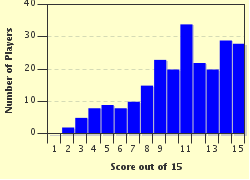Quiz Answer Key and Fun Facts
1. In 1843, Charles Dickens wrote one of the earliest works of fiction to feature a person being transported into both the past and the future. What is the name of this story?
2. In 1889, readers were entertained by a fanciful story involving time travel, called "A Connecticut Yankee in King Arthur's Court". Who wrote this work?
3. In 1895, H. G. Wells wrote what is arguably the most famous work of fiction involving time travel - a novella called "The Time Machine". What name was given to the inventor of the time machine in this novella?
4. In 1939, L. Sprague de Camp wrote "Lest Darkness Fall", a novel about an archaeologist who is transported back in time during a thunderstorm, and then uses his knowledge to try to prevent the onset of the Dark Ages. To what time and place is the character transported?
5. In 1946, a novella called "Vintage Season" told a tale about people from the future who travel back in time as tourists. It became a classic of science fiction literature, and in 1992, a film version of the story, starring Jeff Daniels, was released. What was the name of the film adaptation of the novella?
6. In 1952, Ray Bradbury wrote a famous short story called "A Sound of Thunder", which was about a 21st century company that provides a time travel service for wealthy businessmen who wish to hunt exotic animals from the past. What kind of creature is hunted in this story?
7. In 1955, a novel called "The End of Eternity" demonstrated the paradoxes that time travel can create. Its author became famous for his contributions to science fiction literature, which include "Foundation" and "I, Robot". What was his name?
8. In 1966, Michael Moorcock wrote a novella called "Behold the Man", in which a man from 1970 uses a time machine to travel to the year 28 AD, in the hope of meeting which of the following people?
9. In 1969, Kurt Vonnegut Jr. wrote a novel which features aliens who resemble toilet brushes, and a protagonist who constantly travels to the past and future, reliving parts of his life. What is the name of this bizarre but highly-acclaimed work?
10. In 1979, Karl Alexander wrote a fanciful novel called "Time After Time". In this story, the Victorian age author H. G. Wells invents a time machine and uses it to pursue an infamous villain of history across time. Can you name the villain of this tale?
11. In 1980, Douglas Adams wrote the second book in what would become a "five-part trilogy". In this story, the protagonists travel through time to reach a famous establishment that offers great dining and a spectacular view. What is the title of this hilarious novel?
12. In 1980, Gregory Benford wrote "Timescape", a novel in which messages are sent backwards in time via subatomic particles that travel faster than light. What name, meaning "very fast particles", is given to these normally hypothetical particles, both in the novel, and in modern day physics?
13. In 1990, Stephen King wrote the novella "The Langoliers", in which ten people pass through a rip in time, and become trapped in a kind of limbo in the past. What type of transport takes these people back in time?
14. In 1992, Diana Gabaldon wrote "Outlander", an epic novel about a British Army nurse from 1946, who is suddenly transported to Scotland in 1743. Through what medium does she travel back in time?
15. In 2005, S. M. Stirling wrote the novel "Island in the Sea of Time", which describes how an entire US island, along with its town, is transported 3000 years into the past, due to a time-space disturbance. In real life, this island is famous for its whaling history. What is its name?
Source: Author
Wizzid
This quiz was reviewed by FunTrivia editor
LadyCaitriona before going online.
Any errors found in FunTrivia content are routinely corrected through our feedback system.

